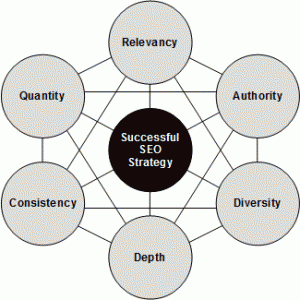Understand the 6 levers to SEO.
23 Mar
Search engine optimization is a subject that requires continuous study and practice, because Google is constantly updating its ranking algorithms. However, there are basic principles of SEO that hold true. I call these the 6 levers to SEO.

Whenever you read about specific SEO tactics, it helps to anchor that discussion against these 6 levers. You want your SEO strategy to span across all 6 levers and not focus on any single one.
With no particular order, here they are:
- Quantity – This is a self evident one. The more incoming links, the higher you will rank for that keyword, the merrier you will be. Everyone knows you want to gather a lot of links. The remaining 5 levers speak more to how you go about selecting these links.
- Relevancy – The more relevant the incoming link source is, the better. In other words, let’s say you have a blog about cats. Ideally, you want the backlink to be from another site about cats. A backlink from a site about dogs is better than a backlink from a site about modern warfare. If you have a lot of inbound links from irrelevant sites, this may in fact raise a red flag. Google will wonder why so many unrelated sites are linking to you. Are you spamming them? Are you paying for these links?
- Authority – You want backlinks from sites that Google considers to have high authority. These are reputable, trusted sites, such as CNN.com, Wikipedia, a .EDU site. A good way to gauge authority is by looking at the site’s Google PageRank. The higher the PageRank, the better. To check a a site’s PageRank, you can either install the Google toolbar or use a free service, like this one.
- Diversity – You want to acquire links from a diverse link source base. Diversity not only refers to links coming from different domains, from different server IPs, but more importantly, it refers to links from different categories of sites. You want links from blogs, links from social bookmarking sites, links from articles directories, etc. A diverse backlink base shows Google that a lot of different types of audiences value your site. It also looks more natural.
- Depth – This lever refers layering or tiering your inbound links. Most beginners only focus on the first tier of links. The first tier of links are links that link directly to your site. They will spend a lot of time and effort writing and distributing articles, publishing posts to external blogs, posting on forums, etc., and generating a lot of links that link directly to their site. However, with all this effort, they only get an initial surge in SERP increases, not nearly enough to get high on page 1 of Google. This is because their linking strategy lacks depth. After you build quality tier 1 backlinks, you need to build a second tier of links that link to the pages housing the tier 1 links. Ideally, you want to build a third tier that links to the second, and so forth. The logic behind this is straightforward. First, with depth, you are building up the authority of your tier 1 links. Secondly, if you have a lot of incoming links with minimal authority, Google will think, this guy is just building links himself. Other people aren’t naturally linking to this web site, because they think his site is valuable. (When building depth, it is important to randomize your structure. You don’t want to leave a “footprint.” This, however, is a topic beyond the scope of this post. :)).
- Consistency – When you browse webmaster forums, people are always scared about getting put in the “Google sandbox” or doing the “Google dance.” They observe that, after some aggressive SEO efforts, they start climbing the ranks. Then, one day, suddenly, they drop into oblivion. The reason for this is a lack of consistency, where consistency refers to consistency of SEO effort. If you buy 10,000 backlinks from someone in 1 month, but never again, Google will reward you initially when it starts coming across those 10,000 backlinks. However, after Google has crawled the 10,000 backlinks and suddenly, it’s not finding any more new links, Google will definitely feel suspicious and may drop your rank! On the other hand, if you consistently build 10,000 links every month, you should be fine. (As a side note, if you find someone selling 10,000 links for a low price, they are probably spam links, which, needless to say, are bad. Stay away from those.)
If you have any questions on any of these levers, please feel free to ask in a comment.
In constructing your SEO strategy, the key is to incorporate all 6 levers. In fact, focusing purely on 1 lever may yield negative results. For instance, if you focus only on quantity, without relevancy or depth, Google may view your site as harvesting spam links and drop your rankings. For a great example of a SEO strategy that incorporates all 6 levers, check out my explanation of the SEO Matrix. The SEO Matrix is the strategy I use most often in ranking both new and established sites.
Best of luck on your SEO endeavors!
dave












great post dave. thanks for giving this broad overview. it helped me a lot since i am new to SEO.